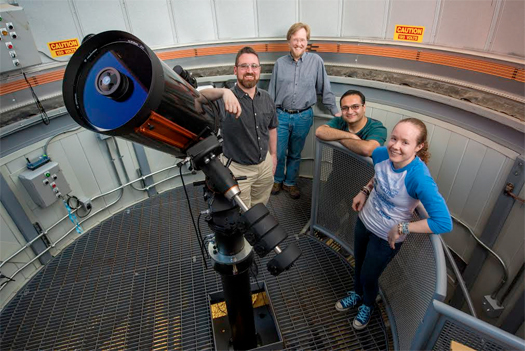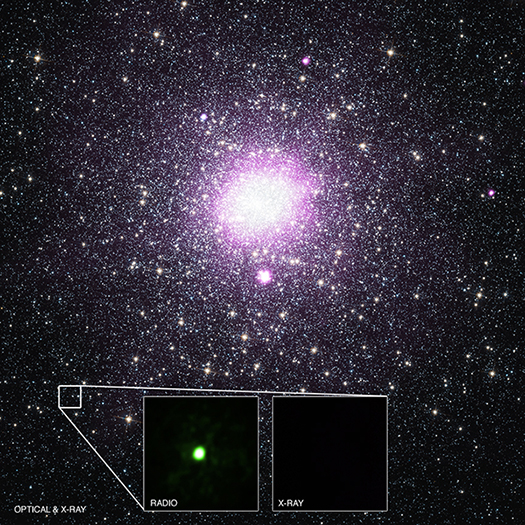Tracking Down a Stealthy Black Hole
We are pleased to welcome Bailey Tetarenko as our guest blogger. She is the lead author on a paper featured in our latest press release about a possible new population of black holes in the Galaxy. Bailey received her undergraduate degree in Astrophysics at the University of Calgary and then a master’s in Physics at the University of Alberta in 2014. She is now two years into her Ph.D. in Physics at the University of Alberta, where she is studying the black hole population of the Milky Way.

From right to left Bailey Tetarenko, Dr. Arash Bahramian and Dr. Craig Heinke and Dr. Greg Sivakoff. Credit: John Ulan
For fans of black holes, we live in exciting times. Nearly all of our empirical knowledge about stellar mass black holes – that is, black holes weighing about 5 to 35 times the mass of the sun – comes from black hole X-ray binary systems. In these systems a black hole pulls in material from a nearby companion star, causing the system to become very bright in X-rays. But, recently gravitational waves have been detected from pairs of distant black holes that emit no electromagnetic radiation (a.k.a. all forms of light). And now, my team's work suggests that there are many black hole X-ray binaries in our own Milky Way that emit relatively little X-rays.
Astronomers have identified about 80 systems in our Milky Way that may be black hole X-ray binaries. Most of these change dramatically over time, cycling between periods of faint emission (quiescent state) and bright emission (outburst state). Nearly all of these were discovered during the outbursts of bright X-ray emission.
In recent years, astronomers have combined data from the most sensitive X-ray and radio telescopes available to detect and identify a handful of quiescent black hole X-ray binary systems in globular clusters (concentrations of thousands to millions of stars) within our Milky Way. Unless one knows the distance to a given source outside of a globular cluster, that source is much more likely to be in another galaxy than in our Milky Way. Thus, it is not surprising that, until now, only black hole X-ray binary systems in globular clusters of the Milky Way were identified by their quiescent emission.
In early 2014, a fellow graduate student at the University of Alberta at that time (Robin
Arnason) came across a potentially interesting object, VLA J213002.08+120904 (we shorten this mouthful to VLA J2130+12), located in the direction of the globular cluster M15. Since this source was only about 1/60th of a degree away (a relatively short measurement of distance between objects in the sky) from the core of M15, most astronomers studying M15 believed VLA J2130+12 was in a background galaxy. However, using a campaign of high-angular resolution radio observations designed to study how the radio sources in M15 move, a team of astronomers (Kirsten et al. 2014) surprisingly showed that VLA J2130+12 was neither a background source nor associated with M15. Given the measured distance and radio properties, Kirsten et al. concluded that VLA J2130+12 was likely an X-ray binary system well in front of M15.
Since Robin was working on another faint X-ray binary in M15, he was surprised that he knew of no X-ray counterpart to VLA J2130+12. As Robin talked to his office mate, graduate student Arash Bahramian, they decided to add all of the Chandra ACIS data together, amounting to a total exposure of 1.2 days. Surprisingly, they did not detect an X-ray counterpart. This means that VLA J2130+12 can only be giving off a small amount of X-rays, making it one of the faintest X-ray binaries known at X-ray wavelengths. In comparison, the X-ray binary that Robin was originally studying varied between 100 and 30,000 times brighter.
Their advisors, Craig Heinke and Gregory Sivakoff, suggested that they compare the radio brightness and X-ray brightness of VLA J2130+12. Since systems made of a compact object (like a black hole or neutron star) that is pulling in material from a nearby star exhibit a strong correlation between X-ray and radio emission, it is possible to distinguish between black hole X-ray binaries and those binaries containing neutron stars and white dwarfs by combining radio and X-ray observations. Given the high ratio in brightness between radio and X-rays, VLA J2130+12’s behavior was most consistent with a quiescent black hole. It looked like VLA J2130+12 was the first Milky Way black hole X-ray binary outside of a globular cluster discovered by its quiescent emission.
So over about the next year, the five of us and a larger group of collaborators began building a solid case for the existence of a black hole in VLA J2130+12. This involved detective work to put the pieces together from a variety of sources, including VLA (radio) data from an unrelated project of ours, archival Hubble (optical) data, and predicting the past locations of VLA J2130+12 in time given its current motion. The radio properties all strongly indicated the presence of an accreting black hole, while the combined multi-wavelength properties and the estimated history of the binary’s motion ruled out a wide variety of other potential sources. In the end, we found that the system likely consists of a 0.1-0.2 solar mass star orbiting closely to a black hole.
Convinced that VLA J2130+12 likely contained a stellar-mass black hole, we began to explore the implications of this discovery. Given the relatively small area over which accurate distances to radio sources have been measured, the discovery of VLA J2130+12 as a black hole X-ray binary implies a large population of black hole X-ray binaries within the Milky Way. While less than 100 have ever been detected, previous estimates of the total population range between 100 and 10,000, using a technique called population synthesis. With this method, detailed computer simulations combine the populations of all of the different types with our knowledge of how stars are born, evolve, and die (and in the case of nearby stars, how they interact), to predict the number of different types of systems in a galaxy. However, by assuming relatively simple models of the likely locations of Galactic X-ray binaries, I was able to estimate that VLA J2130+12 implies at least 26,000 quiescent black hole X-ray binaries in the Milky Way, and possibly millions.
So, why is there a discrepancy, despite decades of research? We hypothesize that most black hole X-ray binaries are in systems where the companion star is very close to the black hole. Such systems will produce low amounts of X-rays, even when actively pulling in material. The all-sky monitoring instruments that have been our most effective resource for discovering new Galactic black hole X-ray binaries are not sensitive enough to detect the shorter, fainter outbursts of these systems. Since the estimates from population synthesis are calibrated against the brighter systems, previous models likely excluded the most numerous class of X-ray binaries.
VLA J2130+12 is representative of a much larger number of hibernating black holes in the Milky Way. However, to identify and confirm the nature of large numbers of the black hole X-ray binary population, and in turn to further our understanding of the formation and evolution of black holes (and neutron star) X-ray binaries, we need to employ new methods. Large-scale radio surveys (looking for nearby sources with the expected spectrum) and/or deep wide-field X-ray surveys of the Galactic bulge (where most of the known black hole X-ray binaries are located) will be essential.
Please note this is a moderated blog. No pornography, spam, profanity or discriminatory remarks are allowed. No personal attacks are allowed. Users should stay on topic to keep it relevant for the readers.
Read the privacy statement

